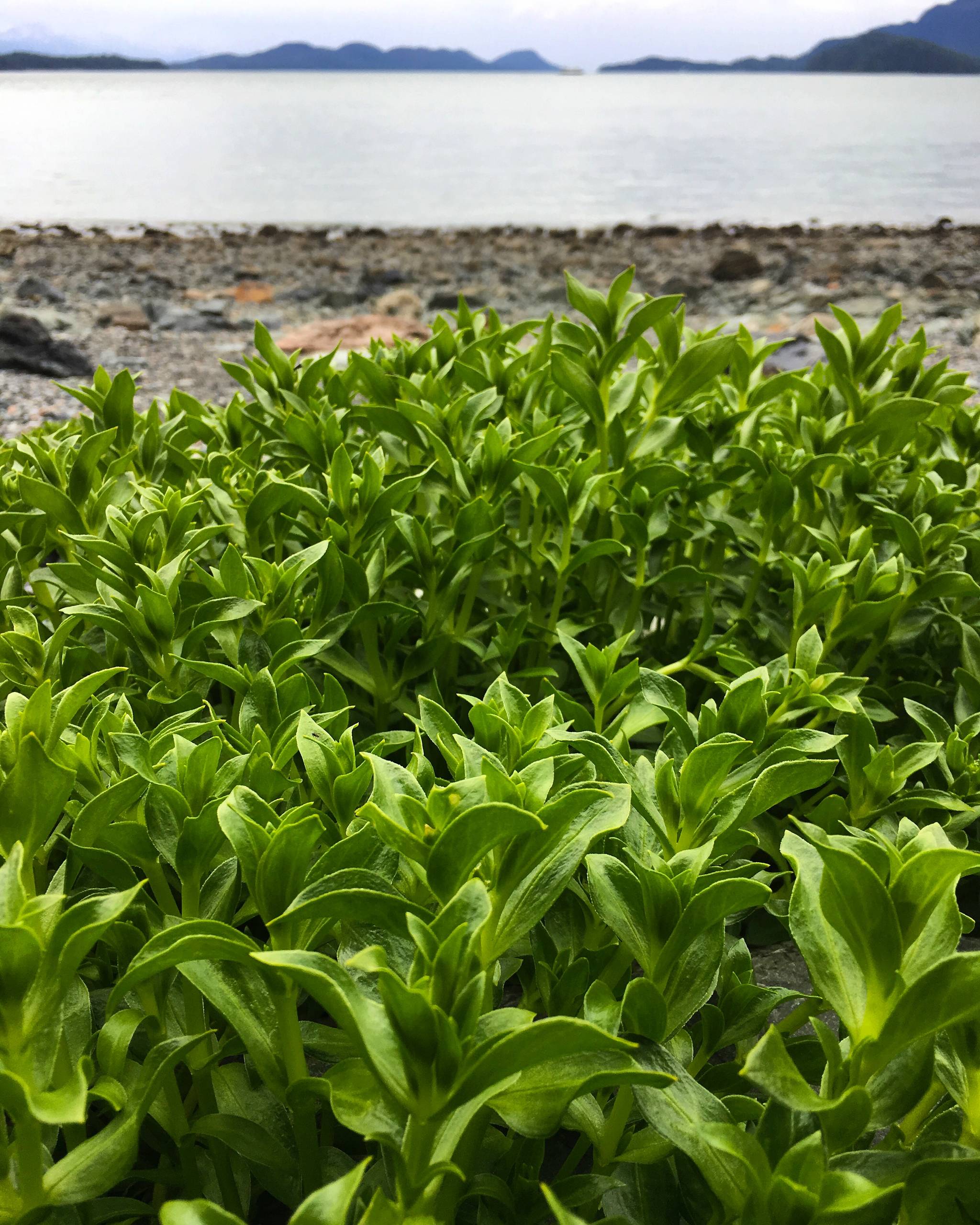I grew up here in Southeast Alaska with a childhood full of blueberries, huckleberries, high-bush cranberries, salmon berries, spruce-tip jelly, sea lettuce and beautiful wild seafood and game. But I didn’t start really foraging until I was an adult. My parents raised us outdoors, but without knowledge of edible plants, they resorted to telling us that just about everything, other than what I listed above, was poisonous. I asked my mother about this recently. “It seemed like the easiest way to keep you from putting everything in your mouth,” she explained.
So I read guidebooks, talked to friends, visited the UAF Cooperative Extension and listened very closely whenever friends and neighbors spoke about foraging. Every day after work I visited a new part of the forest, took a new trail, followed a game path that I’d never been down before. I took notes. I learned about how to forage responsibly and sustainably, only taking what I needed and being careful not to over-harvest, especially if I saw evidence that other people had been harvesting in the same area. I watched the land change through the seasons, thinking about what I found where and when. I’m an enthusiastic hobbyist who passionately loves her home, but my connection to this land and this food, while deeply felt, lies only within myself.
The indigenous communities of Alaska have been living with these plants and this land for millenia. As Vivian Mork Yeilk’ noted in her recent column in the Capital City Weekly “Planet Alaska: Sustainable harvesting and the Alaskan foodie,” these traditions have been marked by the same generational trauma that colonization has brought to so many aspects of traditional indigenous culture in Alaska. My hope is that columns such as this one, and the current fad for foraged food, draws attention to experts like Yeilk’ and respect for traditional ways of living. Learning about these traditional practices and eating the food of this land is another form of expressing love and respect for this place.
Anore Jones’ book “Plants That We Eat” was the first place where I saw mention of the traditional Iñupiat practice of fermenting beach greens. When I think of fermented greens, I immediately think of kimchi, a fermented staple of Korean cuisine, often made with cabbage. What follows is a quick beach greens kimchi recipe inspired by Maangchi’s Emergency Kimchi (Yangbaechu-kimchi). While kimchi is usually fermented this “quick kimchi” skips that step, meaning it won’t give you all the added health benefits and sparkle of fermented foods, but it’s ready right away, tastes good and it scratches that same itch. Use this in omelets, on ramen or rice bowls, as a side to a charcuterie board or eat it straight out of the jar.
Beach greens, a wild green that can be found on beaches all over Alaska — including on the upper edges of Juneau’s rocky beaches — are a beautiful mounding plant with thick green leaves. Use scissors to cut off the top four inches before the plant flowers and you’ll get a tasty green which is delicious lightly steamed, blanched or sauteed. It has a pleasantly bitter taste and texture similar to a mix between cabbage and snap peas. I keep my beach greens in my fridge submerged in a bowl of water for weeks.
Beach Greens Quick Kimchi
Prep: 20 minutes
Makes: ½ a quart
• 1 pound beach greens (or uncooked chopped cabbage)
• 2 tsp salt, divided
• 1 tbsp fish sauce
• 2 tbsp gochugaru (or 1 tbsp red chili flakes)
• 1 tsp sugar
• 1 tbsp grated fresh ginger
• 2 tbsp minced garlic
• 1 tbsp rice vinegar
• 1 carrot, shredded
• ½ apple, shredded
• ½ bunch green onions, diced
• 1 tbsp sesame seeds (optional)
Wash beach greens and pull out any stray grass. Half fill a pot with water and bring to a boil. Submerge beach greens in boiling water for a minute until just wilted. Strain and run greens under cold water until fully cooled or submerge in an ice bath. Place drained greens in a bowl and sprinkle with one teaspoon of salt. Rub salt into greens and set aside. Combine in a small bowl remaining salt, fish sauce, gochugaru, sugar, ginger, garlic, and vinegar and stir into a thick paste. Rinse off beach greens and squeeze out excess moisture. Combine beach greens with carrot, apple, green onions, seasoning paste and sesame seeds. Eat! Store in a lidded jar in your fridge and the flavor will continue to develop over the next day or two.
If you want to experiment with fermenting, leave out the vinegar and keep the kimchi at room temperature, uncovered but with a weight to press down the greens (a ziplock filled with water does nicely). Run a chopstick around the edges of the inside of the jar daily to remove bubbles that form. Taste, and once you reach the fermentation level you like, keep covered in the fridge.
A note on ingredients: This is essentially a delicious, medium-spicy, kimchi-inspired salad. You can absolutely make it with chopped cabbage instead of beach greens. If you use cabbage, skip the boiling water/blanching step. Gochugaru is the Korean red pepper that is the primary ingredient in gochujang, that smoky yummy red pepper paste that is often tableside at Korean restaurants. Gochugaru is ½ to ⅓ as spicy as cayenne, so proceed accordingly. You can find gochugaru and gochujang at Asiana Gifts, the awesome international grocery store in the Mendenhall Mall. Gochugaru and gochujang are a staple in our house and we add one or the other to everything from rubs, to marinades, to stir-frys, to soups to kimchi.
• Erin Anais Heist is a food blogger in Juneau. Readers can contact her at foodabe.com, or on Instagram or Twitter at @erinanais. “Eating Wild” recipes publish every other week.

